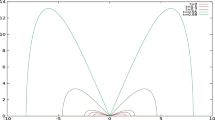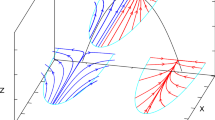Abstract
In this paper, we study the blow-up profiles for a coupled diffusion system with a weighted source term involved in a product with local term. We prove that the solutions have a global blow-up and the profile of the blow-up is precisely determined in all compact subsets of the domain.
Similar content being viewed by others
1 Introduction
In this paper, we consider the following coupled diffusion system with a weighted nonlinear localized sources:
where B is an open ball of , with radius R; α, β, p, q are nonnegative constants and satisfy and .
System (1.2) is usually used as a model to describe heat propagation in a two-component combustible mixture [1]. In this case u and v represent the temperatures of the interacting components, thermal conductivity is supposed constant and equal for both substances, a volume energy release given by some powers of u and v is assumed.
The problem with a nonlinear reaction in a dynamical system taking place only at a single site, of the form
was studied by Pao and Zheng [2] and they obtained the blow-up rates and boundary layer profiles of the solutions.
As for problem (1.2), it is well known that problem (1.2) has a classical, maximal in time solution and that the comparison principle is true (using the methods of [3]). A number of papers have studied problem (1.2) from the point of view of blow-up and global existence (see [4], [5]).
In [6], Chen studied the following problem:
assuming , or , or , he proved that the solution blows up in finite time if the initial data and are large enough.
In the case of , Li and Wang [7] discussed the blow-up properties for this system, and they proved that:
-
(i)
If , this system possesses uniform blow-up profiles.
-
(ii)
If , this system presents single point blow-up patterns.
Recently, Zhang and Yang [8] studied the problem of (1.1), but they only obtained the estimation of the blow-up rate, which is not precisely determined. In [9], the authors proved there are initial data such that simultaneous and non-simultaneous blow-up occur for a diffusion system with weighted localized sources, but they did not study the profile of the blow-up solution. There are many known results concerning blow-up properties for parabolic system equations, of which the reaction terms are of a nonlinear localized type. For more details as regards a parabolic system with localized sources, see [10]–[14].
Our present work is partially motivated by [15]–[18]. The purpose of this paper is to determine the blow-up rate of solutions for a nonlinear parabolic equation system with a weighted localized source. That is, we prove that the solutions u and v blow up simultaneously and that the blow-up rate is uniform in all compact subsets of the domain. Moreover, the blow-up profiles of the solutions are precisely determined.
In the following section, we will build the profile of the blow-up solution of (1.1).
2 Blow-up profile
Throughout this paper, we assume that the functions , , and satisfy the following three conditions:
(A1) ; in B and on ∂B.
(A2) , , and are radially symmetric; , , and are non-increasing for ().
(A3) and satisfy and in B, respectively.
Theorem 2.1
Assume (A1), (A2), and (A3) hold. Letbe the blow-up solution of (1.1), non-decreasing in time, and let the following limits hold uniformly in all compact subsets of B:
-
(i)
If , and , then
where
-
(ii)
If and , then
-
(iii)
If and , then
-
(iv)
If and , then
Throughout this section, we denote
Lemma 2.1
Assume thatis the positive solution of (1.1), which blow up in finite time . Letand, then
Proof
First we claim that . Since , we have
By integrating the above inequality over , we get
From , it follows that . Applying similar arguments as above to the equation of v in system (1.2), it is reasonable that . □
The following lemma will play a key role in proving Theorem 2.1, which will give the relationships among u, v, , and .
Lemma 2.2
Under the conditions of Theorem 2.1, the following statements hold uniformly in any compact subsets of B:
-
(i)
and , then
-
(ii)
and , then
-
(iii)
and , then
-
(iv)
and , then
Proof
-
(i)
When and . A simple computation shows that
(2.1)
and the initial and boundary conditions are given by
Denote , the first eigenvalue of −Δ in and by and the corresponding eigenfunction, normalized by and .
Multiplying both sides of (2.1) and (2.2) by φ and ϕ, respectively, and integrating over , we have, for
We claim that and . In fact, we have , for that is,
Since is non-decreasing, it follows that for all ,
and using , we deduce that , so that (2.3) implies . By a process analogous to above, we arrive at .
Analogous to the proof of Theorem 2.2 in Ref. [18], it can be inferred that
From (2.1) and (2.2), we know is a sub-solution of the following problem:
Equation (2.5) and Lemma 2.1 assert that
uniformly in all compact subsets of B.
The rest of the proof of case (i) is similar to Lemma 2.2(i). Cases (ii), (iii), and (iv) can be treated similarly. Now we prove Theorem 2.1 by using Lemma 2.2. □
Proof of Theorem 2.1
-
(i)
If and . By Lemma 2.2(i), we know that for choosing positive constants , there exists such that
Therefore,
From the right-hand side of (2.7),
Integrating the above inequality over yields
Since and , for any constant , there exists such that for . Hence, from (2.8) it can be deduced that for ,
By an argument similar to above, there exists such that ,
Set , then (2.9) and (2.10) hold simultaneously for all . Next we choose , , , satisfying and with as . Let such that (2.9) and (2.10) hold for . From Lemma 2.2(i), it follows that for such sequences , and , there exists with , as such that
Taking , in terms of (2.9), (2.10), and (2.11), we deduce that for
where .
Since and , integrating (2.12) and (2.13) over we have, for ,
where
Clearly,
By plugging into (2.14) we get
where .
Applying a similar proof to the one above, we can conclude that
where .
According to Lemma 2.2(i), (2.15), and (2.16), it follows that uniformly in all compact subsets of B
The arguments of cases (ii), (iii), and (iv) are very similar to the above, we omit the details. Therefore, we have completed the proof of Theorem 2.1. □
References
Bebernes J, Eberly D: Mathematical Problems from Combustion Theorem. Springer, New York; 1989.
Pao L, Zheng S: Critical exponents and asymptotic estimates of solutions to parabolic systems with localized nonlinear sources. J. Math. Anal. Appl. 2004, 292: 621-635. 10.1016/j.jmaa.2003.12.011
Deng W: Global existence and finite time blow up for a degenerate reaction-diffusion system. Nonlinear Anal. 2005, 60: 977-991. 10.1016/j.na.2004.10.016
Wang L, Chen Q: The asymptotic behavior of blow-up solution of localized nonlinear equation. J. Math. Anal. Appl. 1996, 200: 315-321. 10.1006/jmaa.1996.0207
Wang MX: Global existence and finite time blow up for a reaction-diffusion system. Z. Angew. Math. Phys. 2000, 51: 160-167. 10.1007/PL00001504
Chen H: Global existence and blow-up for a nonlinear reaction-diffusion system. J. Math. Anal. Appl. 1997, 212: 481-492. 10.1006/jmaa.1997.5522
Li H, Wang M: Properties of blow-up solution to a parabolic system with nonlinear localized terms. Discrete Contin. Dyn. Syst. 2005, 13: 683-700. 10.3934/dcds.2005.13.683
Zhang R, Yang Z: Uniform blow-up rates and asymptotic estimates of solutions for diffusion systems with weighted localized sources. J. Appl. Math. Comput. 2010, 32: 429-441. 10.1007/s12190-009-0261-6
Ling Z, Wang Z: Simultaneous and non-simultaneous blow-up criteria of solutions for a diffusion system with weighted localized sources. J. Appl. Math. Comput. 2012, 40: 183-194. 10.1007/s12190-012-0570-z
Bimpong KB, Ross PO: Far-from-equilibrium phenomena at local sites of reaction. J. Chem. Phys. 1974, 80: 3124-3133. 10.1063/1.1681498
Pedersen M, Lin ZG: Coupled diffusion systems with localized nonlinear reactions. Comput. Math. Appl. 2001, 42: 807-816. 10.1016/S0898-1221(01)00200-0
Souplet P: Blow up in nonlocal reaction-diffusion equations. SIAM J. Math. Anal. 1998, 29(6):1301-1334. 10.1137/S0036141097318900
Escobedo M, Herrero M: A semi-linear parabolic system in a bounded domain. Ann. Mat. Pura Appl. (4) 1993, CLXV: 315-336. 10.1007/BF01765854
Li F, Liu B: Non-simultaneous blow-up in parabolic equations coupled via localized sources. Appl. Math. Lett. 2010, 23: 871-874. 10.1016/j.aml.2010.03.025
Liu QL, Li YX, Gao HJ: Uniform blow-up rate for diffusion equations with nonlocal nonlinear source. Nonlinear Anal. 2007, 67: 1947-1957. 10.1016/j.na.2006.08.030
Kong L, Wang J, Zheng S: Asymptotic analysis to a parabolic equation with a weighted localized source. Appl. Math. Comput. 2008, 197: 819-827. 10.1016/j.amc.2007.08.016
Liu QL, Li YX, Gao HJ: Uniform blow-up rate for diffusion equations with localized nonlinear source. J. Math. Anal. Appl. 2006, 320: 771-778. 10.1016/j.jmaa.2005.07.058
Zeng WL, Lu XB, Tan XH: Uniform blow-up rate for a porous medium equation with a weighted localized source. Bound. Value Probl. 2011., 2011: 10.1186/1687-2770-2011-57
Acknowledgements
This work was supported by the National Natural Science Foundation of China under Grant 61374194, the China Postdoctoral Science Foundation Founded Project under Grant 2013M540405, the National Key Technologies R&D Program of China under Grant 2009BAG13A06, the National High-tech R&D Program of China (863 Program) under Grant 2008AA040202, and the Natural Science Foundation of Jiangsu Province under grant BK20140638.
Author information
Authors and Affiliations
Corresponding author
Additional information
Competing interests
The authors declare that they have no competing interests.
Authors’ contributions
All the authors typed, read, and approved the final manuscript.
Rights and permissions
Open Access This article is distributed under the terms of the Creative Commons Attribution 4.0 International License (https://creativecommons.org/licenses/by/4.0), which permits use, duplication, adaptation, distribution, and reproduction in any medium or format, as long as you give appropriate credit to the original author(s) and the source, provide a link to the Creative Commons license, and indicate if changes were made.
About this article
Cite this article
Zeng, W., Liu, C., Lu, X. et al. Profiles of blow-up solution of a weighted diffusion system. Bound Value Probl 2014, 143 (2014). https://doi.org/10.1186/s13661-014-0143-1
Received:
Accepted:
Published:
DOI: https://doi.org/10.1186/s13661-014-0143-1




